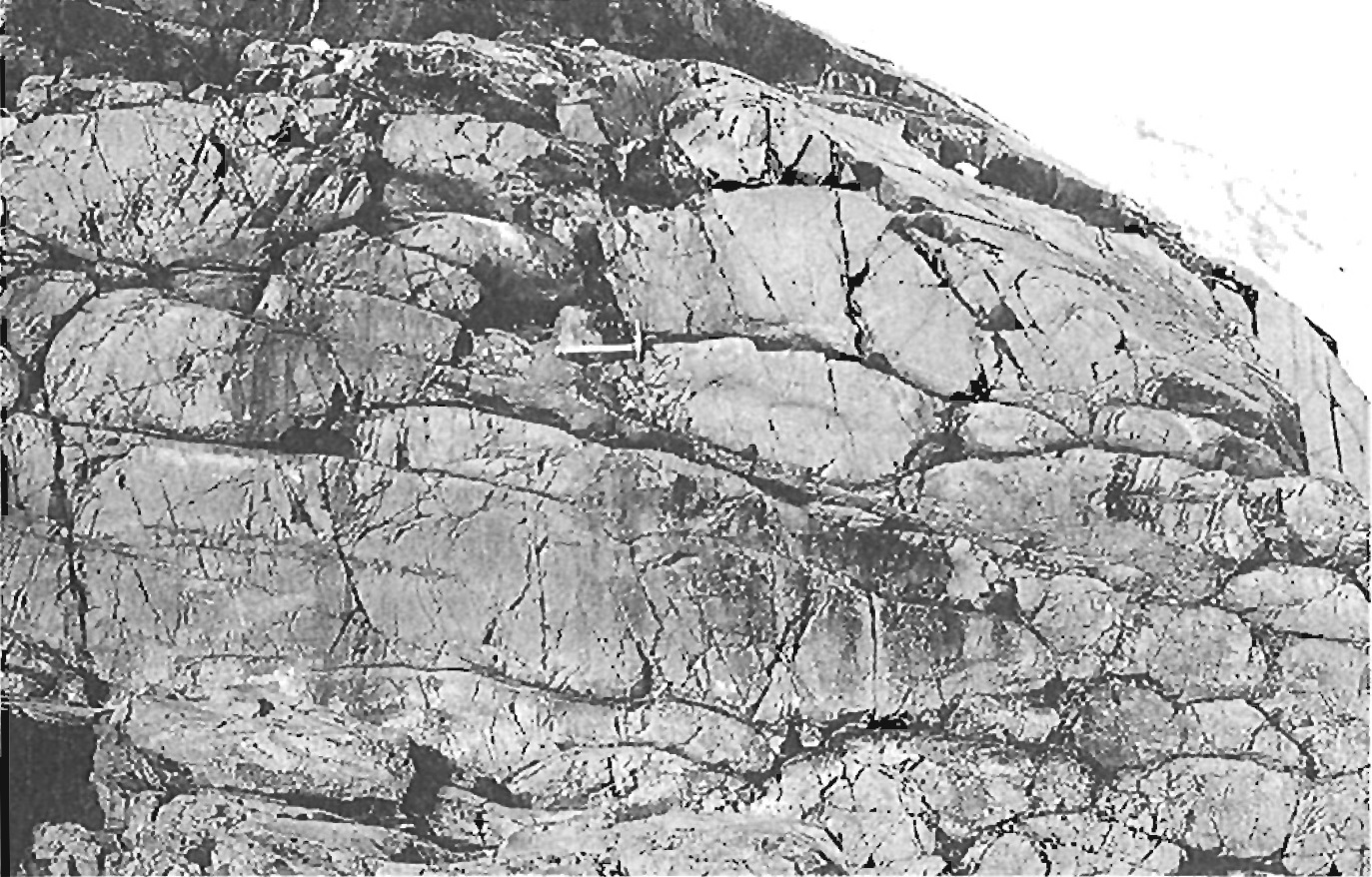
Last modified: 15 October 2019
Translation of original French
| Author: | Bergeron, 1959 |
| Age: | Paleoproterozoic |
| Reference section: | None |
| Type area: | Section comprised between Kuuvvaluk River (NTS sheet 35G04) and Chukotak Lake (sheet 35G05) |
| Geological province: | Churchill Province |
| Geological subdivision: | Ungava Orogen / Ungava Trough / Southern Domain |
| Lithology: | Volcano-sedimentary rocks |
| Type: | Lithostratigraphic |
| Rank: | Group |
| Status: | Formal |
| Use: | Active |
- Povungnituk Group
Background
The Povungnituk Group was created by Bergeron (1959) in the Cape Smith Belt to identify a volcano-sedimentary rock package that unconformably overlies Archean bedrock. The work of Hynes and Francis (1982) and Francis et al. (1983) subsequently described the stratigraphy, structure and geochemistry of rocks of the Povungnituk and Chukotat groups. Lamothe et al. (1984) divided the Povungnituk Group into two subgroups. At the base, the Lamarche subgroup consists of a predominantly sedimentary rock package. Overlying the latter, the Beauparlant Subgroup consists mainly of volcanic or volcaniclastic units. These subdivisions were subsequently maintained by Ministère‘s researchers (Roy, 1985, 1989; Moorhead, 1986, 1988, 1989, 1996a, 1996b; Togola, 1992). In accordance with the North American Stratigraphic Code, the use of these two subgroups has been discontinued in this compilation. Three of the eight formations of the Povungnituk Group were introduced by Lamothe (1994), namely the Beauparlant, Cécilia and Nuvilic formations. The other five units, namely the Korak, Kuuvvaluk, Leclair, Nituk and Natirnaalik formations, are newly introduced in this record.
Description
The Povungnituk Group unconformably lies on Archean bedrock (Taylor, 1982; St-Onge et al., 1988; Moorhead, 1988, 1996b). Because of tectonic overprinting, this discordance is only visible very locally at the contact between bedrock and thin beds of lenticular conglomerate or in erosion klippes at the eastern end of the orogen. Apart from these sparse autochthonous units, all units forming the Povungnituk Group are allochthonous, forming imbricate slices connected to a basal decollement fault (St-Onge et al., 1988). The distribution of the lower Povungnituk sedimentary units indicates an increasingly distal setting and gradual deepening from south to north.
Thickness and Distribution
The Povungnituk Group extends laterally for more than 370 km in an ENE orientation, mainly in the southern part of the Ungava Orogen Southern Domain.
Dating
The zircon U-Pb analysis from an intrusion of the Lac Bélanger Suite, cutting the base of the Povungnituk sedimentary sequence, dates the rift opening in Archean bedrock at >2038 ±2 Ma (Machado et al., 1993). Considering that the age of the Chukotat Group’s volcanism, which overlies and overthrusts the Povungnituk Group, is dated 1882.1 ±2 Ma (Bleeker and Kamo, 2018), the total duration of the Povungnituk phase (that is, from progressive opening of the continental rift to the appearance of MORB volcanism) is thus ~156 Ma.
Stratigraphic Relationship(s)
The Korak Formation, the basal unit of the Povungnituk Group, unconformably overlies Archean bedrock and is truncated at the top by a basal decollement fault. Other Povungnituk units overlie this fault and are therefore allochthonous, except in Burgoyne Bay erosion klippes where the decollement is higher in the sedimentary sequence (St-Onge et al., 1988), preserving layers corresponding to lateral equivalents of units such as the Kuuvvalik and Nituk formations. Volcanic units of the Povungnituk Group were geochemically correlated with the Eskimo and Flaherty formations of the Belcher Islands (Legault et al., 1994; Dunphy et al., 1995). The summit of the Povungnituk Group is stratigraphically and structurally overlain (thrust contact) by the Chukotat Group.
Paleontology
Does not apply.
References
| Author(s) | Title | Year of Publication | Hyperlink (EXAMINE or Other) |
|---|---|---|---|
| BERGERON, R. | Rapport préliminaire sur la région des monts Povungnituk, Nouveau-Québec. Ministère des Mines, Québec: RP 392, 9 pages, 1 carte. | 1959 | RP 392 |
| BLEEKER, W. – KAMO, S.L. | Extent, origin, and deposit-scale controls of the 1883 Ma Circum-Superior large igneous province, northern Manitoba, Ontario, Quebec, Nunavut and Labrador. In Targeted Geoscience Initiative: 2017 report of activities, volume 2; by Rogers, N (ed.); Geological Survey of Canada, Open File 8373, pages 5–14. | 2018 | Source |
| FRANCIS, D.M. – LUDDEN, J. – HYNES, A.J. | Magma evolution in a Proterozoic rifting environment. Journal of Petrology; volume 24, no. 4, pages 556–582. | 1983 | |
| HYNES, A.J. – FRANCIS, D.M. | A transect of the early Proterozoic Cape-Smith fold belt, New Quebec. Tectonophysics, volume 88, pages 23–59. | 1982 | Source |
| LAMOTHE, D. | Lexique stratigraphique de l’Orogène de l’Ungava. Ministère des Ressources naturelles, 62 pages. | 2007 | |
| LAMOTHE, D. | Géologie de la Fosse de l’Ungava, Nouveau-Québec. In Géologie du Québec (Hocq, M., coordonnateur). Ministère des Ressources naturelles, pages 67–74. | 1994 | |
| MOORHEAD, J. | Géologie de la région du lac Vigneau, Fosse de l’Ungava. Ministère de l’Énergie et des Ressources, Québec; DP 88-05, 1 carte. | 1988 | |
| PICARD, C. – LAMOTHE, D. – PIBOULE, M. – OLIVIER, R. | Magmatic and geotectonic evolution of a Proterozoic oceanic basin system: the Cape Smith Thrust-Fold Belt (New Quebec). Precambrian Research; volume 47, pages 223–249. | 1990 | Source |
| ST-ONGE, M.R. – LUCAS, S.B. | Geology of the Eastern Cape Smith Belt: Parts of the Kangiqsujuaq, Cratère du Nouveau-Québec, and Lacs Nuvilik map areas, Quebec. Commission géologique du Canada; Mémoire 438, 110 pages. | 1993 | Source |
| ST-ONGE, M.R. – LUCAS, S.B. – SCOTT, D.J. – BÉGIN N.J. – HELMSTAEDT, H. – CARMICHAEL, D.M. | Thin-skinned imbrication and subsequent thick-skinned folding of rift-fill, transitional-crust, and ophiolite suites in the 1.9 Ga Cape Smith Belt, Northern Quebec; Commission géologique du Canada; Papier 88-1C, pages 1–18. | 1988 | Source |
| TAYLOR, F.C. | Reconnaissance geology of a part of the Canadian Shield, northern Quebec and Northwest Territories. Commission géologique du Canada; Mémoire 399, 32 pages. | 1982 | Source |

